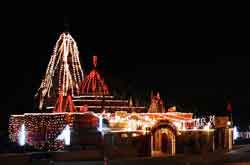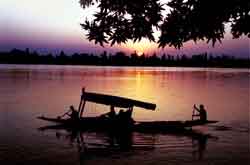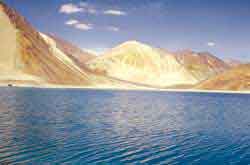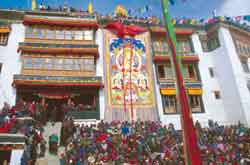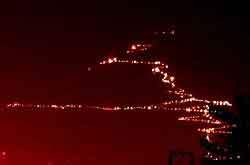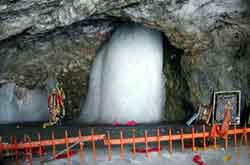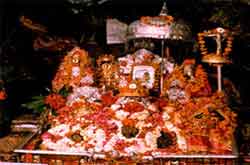How to reach Ladakh by Air & Road - Guide
Air Travel -The flight route to Leh presents the visitors with a spectacular panoramic view of snow-capped ranges spread out below, and the thrill of identifying particular landmarks. The twin peaks of Nun and Kun stand out high above the others. Tso-moriri lies intensely blue among bare brown hills. The Zanskar River snakes through the mountains, and one route of flight takes you directly above the Zanskar valley, with villages and gompas clearly visible. Far to the northwest, the giants of the Baltistan Karakoram dominate all the other peaks and ranges. A number of Airlines operates regular scheduled flights to Leh from Delhi, Chandigarh, Jammu and Srinagar.
Internal Transport - The cheapest way to travel within the region is by public buses, which operate on various routes according to fixed time schedules. However, the most comfortable and convenient, though expensive, mode of travel is by taxis, which are available for hire on the basis of fixed point-to-point tariff. For visits to the newly opened areas of Nubra, Changthang and Dah-Hanu, it is necessary to engage the services of a registered / recognized travel agency for making all requisite arrangements including internal transport. For the current taxi fare to various tourist destinations inquire at the Tourist Office of J&K Government.
Road Travel - You have a choice of reach Ladakh by Road from either of the two routes, one from Kashmir in J&K and the other from Manali in Himachal Pradesh, both offering a spectacular view on its way especially for mountain travel enthusiasts.
Road Travel from Kashmir - The main overland approach to Ladakh is from the Kashmir Valley through the 434-km Srinagar-Leh highway, which follows the historic trade route, also known as the ‘Treaty Road’. It generally remains open for traffic from early June to mid-November. This road journey provides the best possible introduction to the land and its people. At one step, as you cross the Zoji-la Pass (11,500-ft./3,505 m), one passes the lushness of Kashmir into the barren contours of a trans-Himalayan landscape. Drass, the first township over the pass, inhabited by a population of mainly Dard origin, has the local reputation of being the second coldest inhabited place in the world. But in summer when the pass is open and travellers are going through, the standing crops and clumps of willow give it a gentle look. After Drass, the valley narrows down to almost a gorge. Yet even here it occasionally opens up to allow small patches of terraced cultivation, where a small village population ekes out a precarious existence.
On leaving Kargil town, the road plunges into the ridges and valleys of the Zanskar Range, over a huge mound of alluvium known as Khurbathang plateau, now made fertile by a huge irrigation system. Form here it descends to the Pashkyum area and passes through several roadside villages before entering Mulbek, with its gigantic rock carving of Maitreya Buddha and a gompa perched high on a crag above the village. Mulbek is the transition from Muslim to Buddhist Ladakh. Two more passes, Namika-la (12,200 ft/3,719 m) and Fotu-la (13,432 ft/4,094 m) follow the exit out of Mulbek valley.From Fotu1a, the road descends in sweeps and turns, past the spectacularly sited monastery of Lamayuru and the amazing wind-eroded towers and pinnacles of lunar-landscape rocks, down to the Indus at Khalatse - a descent of almost 4,000 ft / 1,219 m, in about 32 kms. From here the road follows the river, passing villages with their terraced fields and neat whitewashed houses, the roofs piled high with neat stacks of fodder laid in against the coming winter. Here and there one notices the ruins of an ancient fort or palace or the distant glimpse of a gompa on a hill. And at last Leh is visible, dominated by the bulk of its imposing 17th century palace.
Road Travel from Manali - The 473 km Manali- Leh Road is open for about three months in the year from early July to September. For much of its length, it passes through areas so barren that it is entirely void of habitation. Lahoul district, through which the road passes, is a typically trans-Himalayan landscape. The first major pass in this road, the Rohtang pass (13,000 ft / 3,978m) which is crossed soon after departure from Manali, cuts through the Pir Panjal range of the Great Himalayas. Lahouli houses are built in the Ladakhi pattern, out of sun-dried bricks. Whitewashed and flat-roofed, they stand among the irrigated fields of the villages, which cling to the mountain slopes. Beyond Keylang, the region's main town, the road follows the Bhaga River up towards its source, passing a few more villages, the last till the territory of Ladakh is entered. Now it hairpins up to the Baralacha-la (16,050 ft / 4,892m), which is a tri-junction, with a trail from Spiti also joining in from the southeast. This is the crossing of the Great Himalayan Range, the watershed between the Indus and the Chenab. Now the barren landscape becomes positively lunar with dusty plains stretching into the distance.
The Zanskar Range, which lies next on this road, is crossed through two more passes, the Lachulung-la (16,600 ft / 5,059m) and the Taglang-la (17,469 ft / 5,325rn). Between these two, there is nothing but rock and sand, rolling hills and broad plains scoured by dust devils. An occasional pasture here and there provides nourishment for the flocks of the nomadic Chang-pa herdspeople who are the region's only inhabitants, apart from the seasonal entrepreneurs from Leh and Lahoul, who erect tents and shacks at various points along the road, to cater to the needs of travellers. Once over the Taglang-la, the descent to the Indus starts, and soon one passes the first village, Rumtse. The road follows the Gya River down to the Indus at Upshi, from where it is plain sailing to Leh, past the Indus valley villages of Karu, Stakna, Thikse, Shey and finally the Tibetan village at Choglamsar, before entering the town.
Public Transport Facilities -
The J&K State Road Transport Corporation (J&K SRTC) operates regular buses between Srinagar and Leh, with an overnight halt at Kargil. Taxis are also available at Srinagar and Leh for the journey. Groups have the choice to charter deluxe buses from the J&K SRTC at Srinagar. On the Leh- Manali route, J&K SRTC and H.P. Tourism operate deluxe and ordinary buses. The bus journey between Leh and Manali takes about 19 hours or two days, with an overnight halt in camps with basic facilities, at Serchu or Pang.

